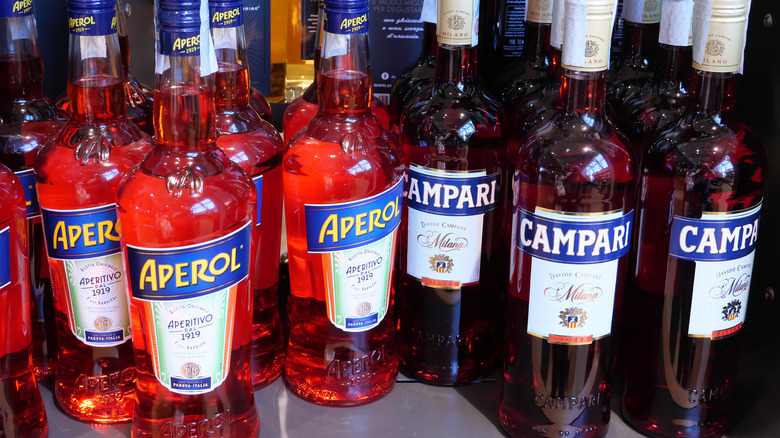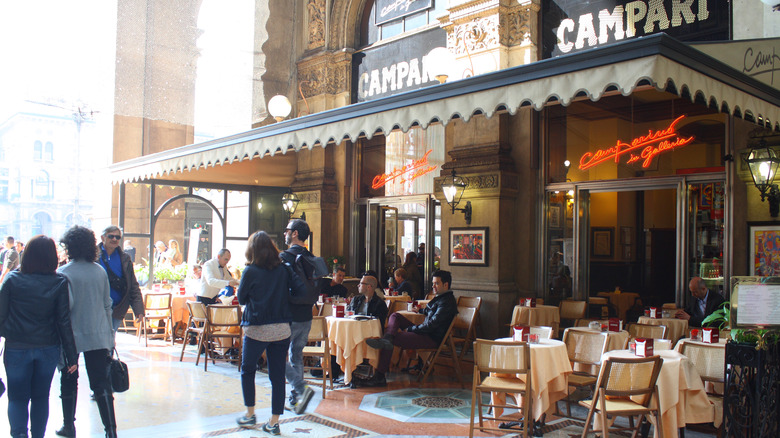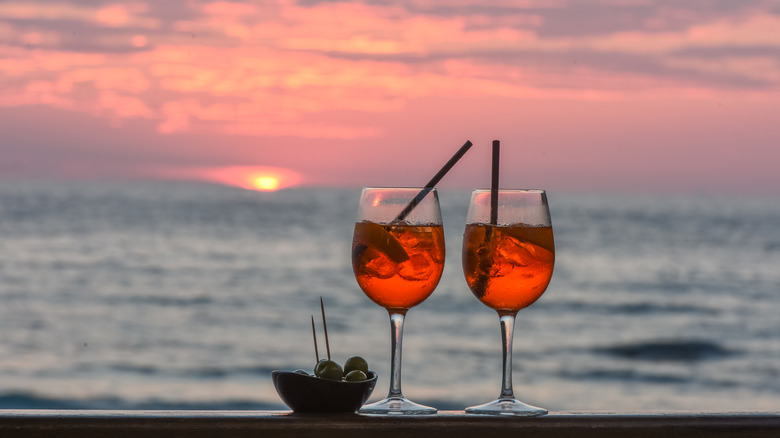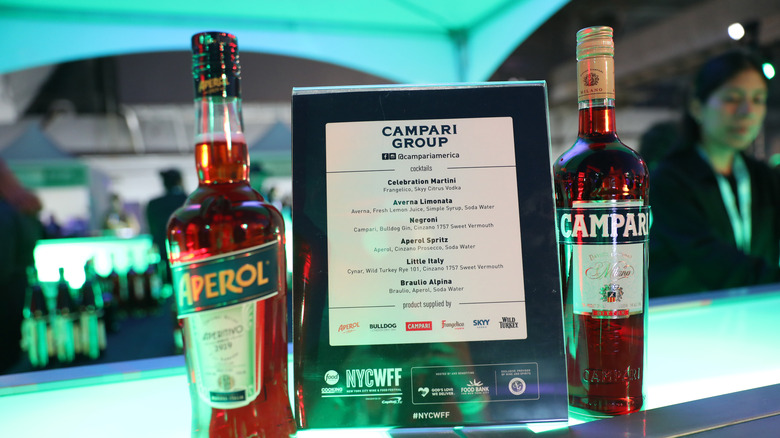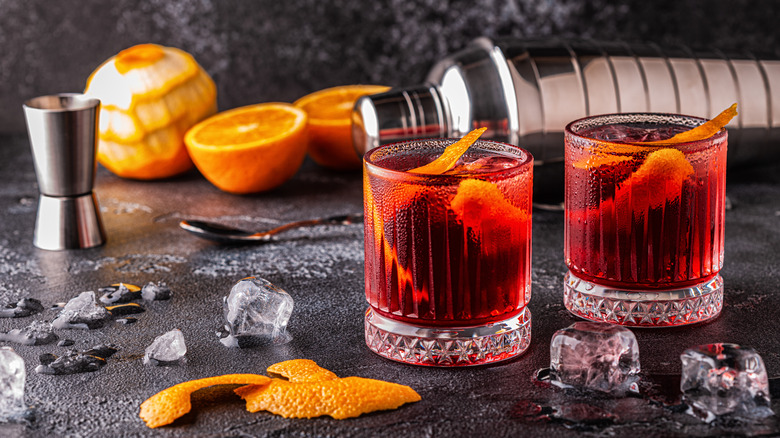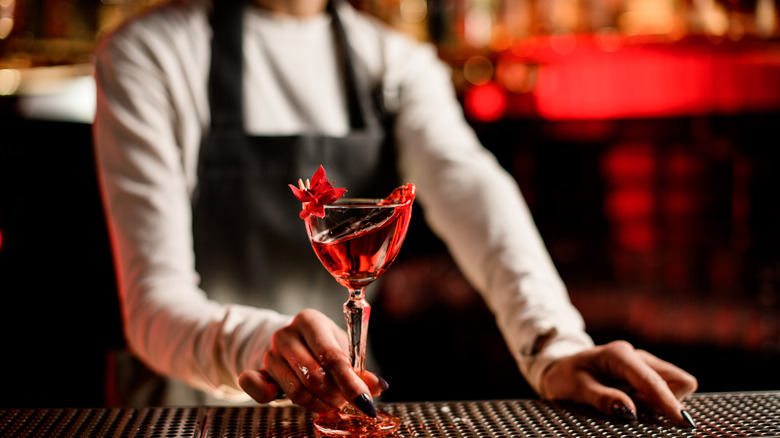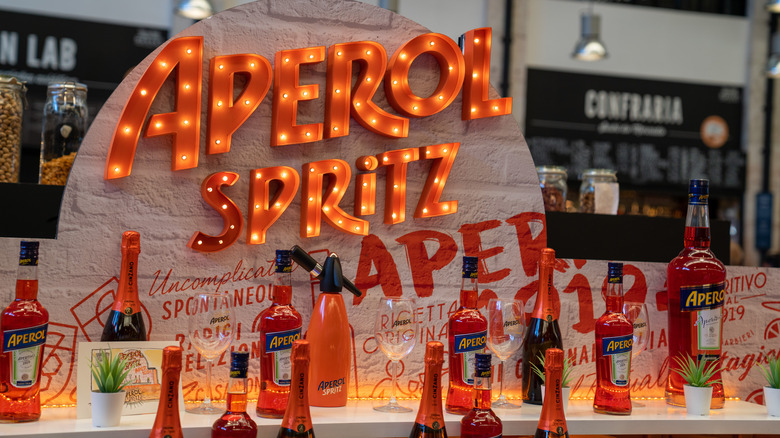The Difference Between Aperol And Campari
Liquor stores and bar shelves stock a wide selection of familiar favorites and continuously evolving novelty products. With so many choices, it can be hard for one bottle to stand out over another, yet Aperol and Campari have a huge advantage. Vibrant orange and red respectively, the two spirits beg to be noticed. And once you do, you might just be hooked. Although they have a number of overlapping features and are sometimes used interchangeably in drinks, the boldly colored duo should be differentiated.
Unlike stronger spirits like vodka or whiskey, Aperol and Campari are aperitivo liqueurs, or aperitifs. The term traditionally refers to any pre-dinner beverage — including Champagne, vermouth, beer, or a cocktail — that's intended to open the palate and prepare it for the forthcoming meal. Accordingly, the two liqueurs sport a lower ABV to match their purpose. The popularity of Italian aperitivo cocktails has reached a fever pitch in recent years, especially in big cities where the Negroni and Aperol spritz are definitively the fashionable cocktails of choice.
Whether you're looking for a new early evening drink or have pondered the difference between Aperol and Campari to no end, let's break it down so that you can get the most out of every electric-colored sip.
Both Campari and Aperol began in Northern Italy
Northern Italy defined aperitivo culture as we know it today — a spread of red or orange spritzes made with bitter liqueurs, Prosecco, and soda water served with a salty spread of bar snacks (via The Telegraph). In the 1800s, taverns around this region of the country each boasted their own house aperitivo, a custom blend created by local bartenders that varied in bitterness, sweetness, and herbal profile.
Yet the category became more formalized in 1860 when Gaspare Campari created Campari Bitter and began selling it at his bar in Milan. The product became increasingly popular, and eventually, the founder's son Davide took over and opened his own bar. Other brands and types of aperitivo soon followed, namely Aperol in 1919. The spirit was another family endeavor, developed by the Barbieri brothers in Padova, also in Northern Italy. The siblings succeeded in creating a lower alcohol aperitivo without sacrificing on flavor.
The Campari Group bought the orange liqueur in 2003, officially combining the brands under one company. Nowadays, both Aperol and Campari have cemented their place in the Italian aperitivo lifestyle as traditional mainstays.
Campari is a deep red while Aperol is bright orange
There's definitely no mistaking the vivacious color of each drink. Campari is crimson red, which Francesco Amodeo, president of the Italian herbal liqueur company Don Ciccio & Figli, describes as a nod to the setting sun and the time of day it's served (via The New York Times). It originally derived its distinctive, mesmerizing color from a natural dye that was once famously sourced from cochineal insects. Eventually, in 2006, the company switched to artificial coloring. According to Alcademics, cochineal dye is still used in some countries as it infuses no flavor.
A hint to its lighter nature, Aperol is both lower on the bitter scale than Campari and flashes a bright orange hue. The two spirits can be served straight but they are more commonly accompanied by other beverages to make a cocktail. Consequently, the intensity of the color can vary widely — even signaling a watered-down drink at times. The ideal ratio is of course subjective, but Aperol's aperitivo expert Paolo Tonellotto created a color chart to depict the perfect spritz (via Good Housekeeping).
Aperol is sweeter and smoother than Campari
Both spirits are known for their complex flavor composed of layered botanical elements, but Aperol is lower on the bitter scale. Historian Eligio Bossetti tells The Telegraph that only a few people know the recipe to recreate Campari, which hasn't been modified since it first graced bar shelves in 1860. The iconic red drink is rumored to contain almost 70 natural ingredients, namely herbs, fruits, and spices (via Difford's Guide). The aperitif is famous for its bittersweet taste, marked by subdued flavors of cherry, cascarilla, clove, rhubarb, cinnamon, and orange peel. A subtle floral aroma rounds it out with a rich finish.
Meanwhile, Aperol takes a lighter approach with zesty notes of orange mingling with herbal aromas. Its flavor is most closely associated with rhubarb, bitter herbs, and burnt orange, and its higher sugar content makes it sweeter and more approachable to bitter neophytes. While it boasts some underlying bittersweetness, a touch of wood and vanilla make it smooth and palatable, not to mention the perfect element to include in a range of cocktail styles.
Campari has a higher ABV than Aperol
According to Difford's Guide, Campari is produced with varying levels of alcohol depending on the regional market. In North America, it sits at 24% ABV, but the value ranges rather substantially from 20.5% in certain African countries, to 28.5% in Eastern Europe. This places the vibrant red liqueur on the boozier end of the spectrum, making it a fair contender against stronger spirits when mixing up cocktails.
If you're debating between a Campari or Aperol, it's worth knowing that the former boasts more than double the alcohol. Thankfully, in Italy, aperitivo time is synonymous with snacks and neither is intended to be sipped on an empty stomach. That being said, at 22 proof (11% ABV), Aperol is a lighter spirit that's perfect for brunch or early-evening cocktails. However, if you find yourself sipping on Aperol in Germany, you might notice a stronger kick. Curiously, as a result of local single-use deposit and recycling regulations, the aperitif clocks in at 15% ABV (via VinePair).
Campari and Aperol are used to make different cocktails
The bittersweet flavor profiles of both Campari and Aperol can stand up to almost any other bottle in the bar, making them excellent for mixing. Campari is the signature ingredient in classic cocktails, such as the Negroni (equal parts gin and red vermouth), Boulevardier (whiskey and sweet vermouth), Americano (sweet vermouth and club soda), and the iconic spritz (with Prosecco and soda water). All four drinks have been recognized by the International Bartenders Association (IBA), the former three categorized among "The Unforgettables."
There are dozens of variations of the Negroni, including the sbagliato ("mistaken" in Italian), which swaps the gin with Prosecco for a lighter take. Conveniently, Campari soda is bottled in a single serving for an easy drink on the go. Another simple two-ingredient recipe is the Garibaldi, made by mixing Campari with orange juice to highlight the citrus notes. Meanwhile, if you really want to try something different, the bitter aperitif is mixed with condensed milk in St. Lucia, where Campari consumption is among the highest per capita (via The Telegraph).
Aperol is typically served as an Aperol spritz, although in recent years it has become a darling of bartenders, who use it in their creative contemporary cocktails. With its subtler citrus twist and lower alcohol content, it is an excellent ingredient in fun drinks like the Paper Plane. Made with equal parts bourbon, amaro, lemon juice, and Aperol, this boozy tangy cocktail is a winner.
Which one comes out on top: Campari or Aperol?
It's hard to label Aperol or Campari as the better aperitif since it really depends on what you're looking for. The argument can be made that the former is more drinkable, but that only focuses on its lighter alcohol content and milder flavor. While that's valuable information if you're planning on drinking bottomless spritzes, Campari's bolder nature makes it a noteworthy element in any cocktail.
Subjective tastes aside, according to Campari Group's 2021 sales summary, Campari makes up 10% of the group's total sales while Aperol counts for 20%. According to Reuters, this difference is partially accounted for due to the fact that marketing efforts largely highlighted Aperol as the foundation for the perfect spritz cocktail. Additionally, the brand is aiming to repurpose the drink as both a pre-dinner option as well as an accompaniment for meal times.
As many people experience and PsychCentral confirms, salty, sweet, and savory tastes are naturally preferred, whereas bitter and sour are more acquired. Although this is partly an evolutionary mechanism to avoid potentially toxic substances, other factors affect likes and dislikes. Of course, both Campari and Aperol offer a range of aromas to balance out the bitterness, as do the various mixers they're paired with in cocktails. Nonetheless, Aperol's subtler taste seems to be more of a crowd pleaser, which is perhaps a relief when considering the results of a 2015 Austrian study published in Appetite, which found that liking bitter flavors was associated with antisocial traits.
